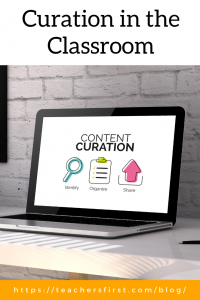Curation in the classroom is not something new to educators; we curate content all the time for lessons, project resources, future ideas, and more. However, curation is also a valuable tool for students! It is a skill they can use in their classes, personal life, and future careers.
Getting started with content curation in the classroom is easy with all of the fantastic resources out there! Teaching curation can be fun. The first step is explaining to students the benefits of curation. When they understand the why of curation, they are more likely to want to curate for themselves. The next step is making sure that students are able to evaluate the quality of resources. If they are curating resources, but they are not good resources, anything they use them for will reflect that. Next, students need to understand the goal of any curation assignments. If they do not understand the goal of a curation assignment, they cannot successfully curate resources. Make sure students understand that the idea is quality, not quantity. Finally, choose the right content curation tool or tools for your students. This is a critical step. If students are using a tool that is too complicated for them to learn and use easily, they will not want to curate content in the future.
Curation tools abound! They are not all the same, and one may be suitable for your classroom where others are not. If your students use Google tools, then Google Keep (reviewed here) may be the right curation tool for your class. There are many ways to use it for curation, collaboration, and more. Wakelet (reviewed here) is a curation tool recently upgraded with student accounts to make it easier to use with your students. There are many ready-made lesson plans available for Wakelet. Padlet (reviewed here) is another tool familiar to many educators. It can also be a great curation tool to use with students that they are already familiar with. There are also platform-specific curation tools available on many museum sites or for specific resources like primary sources; check out the Smithsonian Learning Lab (reviewed here). There are many curation tools out there; find the one that works for you and your students!
Once you have chosen a tool, there are many activities and lessons available that can introduce curation. You can even take a paper lesson plan and take it digital! Some ideas- students can curate all types of resources when doing a research project. They can curate a digital portfolio of their own work; they can curate resources for a “how-to” project and more. If you would like a ready-made curation project, there are many available like these:
- Digital Curation Project from the Anti- Defamation League
- What 2020 news stories mattered most to your students? from PBS Newshour
- 9/11 & Memorialization from Junior Historians
- Our Stories: Students Curate the Museum of Corona History from Rethinking Schools
- Collecting and Curating Meaning-Filled Objects | Craft in America
- An Introduction to Curatorial Thinking
Try out a ready-made project as is, or remix it for your classroom!
Curation can be an engaging and informative activity in your classroom for your students! TeachersFirst has many resources available to you about curation, from blog posts such as Let’s Talk About: Curation for Knowledge Construction by Ruth Okoye to past and upcoming OK2Ask sessions. Teaching curation to our students in this information age is a valuable skill they will use throughout their academic years and beyond. Have a favorite curation tool or lesson idea you use in the classroom? Please share them in the comments below.



What is a good curation tool for K-5 library class?